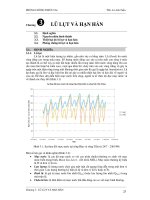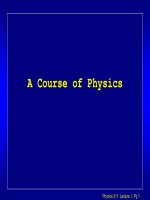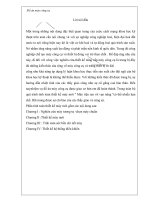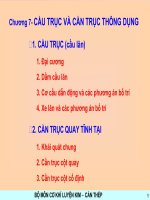Tài liệu Cyclo Drive Catalog (Type: RV-E) docx
Bạn đang xem bản rút gọn của tài liệu. Xem và tải ngay bản đầy đủ của tài liệu tại đây (2.5 MB, 42 trang )
11
ORDERING INFORMATION
1
■RV-E series
●Product identification for ordering purpose.
■RV-C series
●Product identification for ordering purpose.
RV 80 E 121 A B
Main bearing built-in type
E
Type of input gear or
input spline
●
●
Speed ratio (reduction ratio = )
1
―
R
Standard type A (Narrow type)
A
Standard type B (Big diameter type)
B
Special (none)
Z
〈
Ex. RV-80E
〉
Notes1. Refer to the Rating Table for other type.
2. Specify the shaft rotating speed ratio of your
application.
R
shaft rotation 57,81,101,121,153
RV 100 C 36.75 A B
Bolt-clamping
output shaft
Through-bolt
clamping output
shaft
B
●
●
T
Hollow shaft type
C
●
Profile of center gear
●
Speed ratio (reduction ratio = )
1
―
R
Standard type
A
None
Z
Notes1. Here, 36.75 applies to the RV-100C.
2. See Ratings Table for speed ratios of other frame
numbers.
3. Specify the shaft rotating speed ratio of your
application.
Frame number Rated output torque In-lb(Nm)
6 514 (58)
20 1,479 (167)
40 3,649 (412)
80 6,944 (784)
110 9,547(1078)
160 13,887(1568)
320 27,774(3136)
450 39,058(4410)
Frame number Rated output torque In-lb(Nm)
10 867 (98)
27 2,343 (265)
50 4,340 (490)
100 8,680 (980)
200 17,359(1,961)
320 27,775(3,136)
500 43,398(4,900)
Type symbol
●
Frame No.
●
Model
●
Type symbol
●
Frame No.
●
Model
●
Bolt-clamping
output shaft
Bolt/pin
clamping output
shaft
B
●
●
P
2
■RV series
●Product identification for ordering purpose.
RV 60 121 A T
Standard type
No mark
Standard type A (Narrow type)
A
Standard type B (Big diameter type)
B
Special (none)
Z
〈
Ex. RV-60
〉
Notes1. Refer to the rating table for other type.
2. Specify the shaft rotating speed ratio of your
application.
R
shaft rotation 57,81,101,121,153
Frame number Rated output torque In-lb(Nm)
15 1,213 (137)
30 2,949 (333)
60 5,642 (637)
160 13,887(1568)
320 27,774(3136)
450 39,058(4410)
550 47,737(5390)
Type symbol
●
Frame No.
●
Model
●
Bolt-clamping
output shaft
Through-bolt
clamping output
shaft
B
●
●
T
Type of input gear or
input spline
●
●
Speed ratio (reduction ratio = )
1
―
R
3
APPLICATION EXAMPLES
2
Robot Swing Axis
RV-C series
●Allows space-saving design
●Main bearing is not required on
robot side.
Robot arm
RV-C series
●Greater internal resistance to
adverse enovironments-allows safe
throughput of cables.
●Wider operating angle.
Indexing Table
RV-C series
4
Robot arm
RV-E series
Robot Wrist Axis
RV-E series
As shown in the figure(right), the input gear
can also be supported within the reduction
gear mechanism.
Please contact TS Corporation for more
details.
Robot Swing Axis
RV series
5
Positioner
RV-E series
ATC Magazine
RV-E series
RV-C
series
54
RV-C series
FEATURES AND BENEFITS
1
Fig.1
●
Cables and other lines can pass through the reduction gear
●Allows space saving design
Hollow shaft structure
Benefits:
●Increases reliabilty
●Reduces overall cost
Attributed to:
●Built-in angular ball bearing construction improves
ability to support external loads, increases moment
rigidity and maximum allowable moment.
●Reduces the number of components required.
●Simplifies installation and maintenance.
INTEGRATED ANGULAR BALL BEARINGS
Attributed to:
●Low speed rotation of the RV gear reduces
vibration.
●Reduced size of the motor coupling part (input
gear) lowers intertia.
Benefits:
●Reduces vibration
●Reduces inertia (GD
2
)
2 STAGE REDUCTION
Detail:
●Crankshafts are supported on both sides of the
reduction gear as shown below.
Benefits:
●Higher torsional stiffness
●Less vibration
●High shock load capability (5 times rated torque)
ALL MAIN ELEMENTS ARE SUPPORTED FROM BOTH SIDES
Attributed to:
●Use of roller bearings throughout.
Benefits:
●Excellent starting efficiency
●Low wear and longer life
●Low backlash (Less than 1 arc. min.)
ROLLING CONTACT ELEMENTS
Attributed to:
●Synchromeshing of many precision ground gear
teeth and pins.
Benefits:
●Very low backlash (Less than 1 arc. min.)
●
Higher shock load capability (5 times rated torque)
PIN & GEAR STRUCTURE
Clearance hole for rigid
supporting structure
Crankshaft
through hole
RV gear
Rigid supporting structure
Crankshaft bearing supports
Shaft + hold flange
55
CONSTRUCTION and OPERATION PRINCIPLE
2
■Construction
■Principle of speed reduction
Fig.2
The RV-C is a 2-stage reduction gear.
…Spur gear reduction
●An input gear engages with and rotates a center gear which then engages and rotates
spur gears that are coupled to crankshafts. Several overall gear ratios can be provided
by selecting various first stage ratios.
…Epicyclic gear reduction
●Crankshafts driven by the spur gears cause an eccentric motion of two epicyclic gears
called RV gears that are offset 180 degrees from one another to provide a balanced load.
●The eccentric motion of the RV gears causes engagement of the cycloidal shaped gear
teeth with cylindrically shaped pins located around the inside edge of the case.
●In the course of one revolution of the crankshafts the teeth of the RV gear move the
distance of one pin in the opposite direction of the rotating cranks. The motion of the
RV gear is such that the teeth remain in close contact with the pins and many teeth
share the load simultaneously.
●The output can be either the shaft or the case. If the case is fixed, the shaft is the
output. If the shaft is fixed, the case is the output.
2nd stage
1st stage
Fig.3
Crankshaft
Case
Pin
RV gear
Main bearing
Hold flange
Input gear
Shaft
Spur gear
Center gear
Crankshaft rotating angle: 0 degree Rotating angle: 180 degrees Rotating angle: 360 degrees
Case
Crankshaft
(Connected to spur gear)
Shaft
RV gear
Pin
56
RV-C series
ROTARY DIRECTION and SPEED RATIO
3
The rotary direction and speed ratio of the RV-C reduction gear are shown below.
Fig.4
■Speed Ratio
The overall ratio can be determined from the following equation:
With the shaft as output; R=R
1
×
i=
(R
1
=1+・Z
6
)
Z
4
――
Z
3
−1
――
R
Z
2
――
Z
1
Mechanism block drawing
Fig.5
qCase is fixed, shaft output wShaft fixed, case output
i =−
1
―
R
i =
1
―
R
R: Overall speed ratio
R
1
: Speed ratio of a discrete reduction gear
Z
1
: Number of teeth on input gear
Z
2
: Number of teeth on large center gear
Z
3
: Number of teeth on small center gear
Z
4
: Number of teeth on spur gear
Z
5
: Number of teeth on RV gear
Z
6
: Number of pins
i: Reduction ratio
Case
Shaft
Crankshaft
RV gear
Pin
Output
Spur gear
Center gear
2nd reduction 1st reduction
Input gear
57
RATING TABLE
4
Table 1
Notes: 1. The overall speed ration is calculated with the formula in page 56.
2. Set maximum input shaft speed to a value equal to or lower than the value of maximum allowable output speed multiplied by the overall speed ratio
for each type.
3. The input capacity (KW) in the above table is determined by the efficiency of these reduction gears.
4. The output torque (In-lb) is so determined that the service life may be maintained constant for any output revolutions. (N・T= Constant)
5. The rated torque is a torque at an output speed of 15 r/min, which is used as a basis for service life calculations. (Refer to the rated service life, page
61.)
1,204 983 868 797 744 709 647 602
RV-10C
27 0.09 0.16 0.21 0.25 0.29 0.34 0.41 0.47
(136) (111) (98) (90) (84) (80) (73) (68)
36.57 3,259 2,648 2,347 2,152 2,010 1,904 1,745 1,630
RV-27C
0.26 0.42 0.55 0.68 0.79 0.90 1.10 1.29
(1,390/38)(368) (299) (265) (243) (227) (215) (197) (184)
32.54 6,031 4,907 4,340 3,985 3,720 3,525 3,242 3,020
RV-50C
0.48 0.77 1.03 1.26 1.47 1.67 2.04 2.38
(1,985/61)(681) (554) (490) (450) (420) (398) (366) (341)
12,063 9,804 8,679 7,962 7,448 7,050 6,465
RV-100C
36.75 0.95 1.55 2.05 2.51 2.94 3.33 4.08
(1362) (1107) (980) (899) (841) (796) (730)
34.86 24,125 19,617 17,368 15,968 14,932 14,144
RV-200C
1.90 3.09 4.11 5.04 5.88 6.69
(1,499/43)(2,724) (2,215) (1,961) (1,803) (1,686) (1,597)
35.61 38,624 31,335 27,774 25,516 23,824
RV-320C
3.04 4.94 6.57 8.05 9.41
(2,778/78)(4,361) (3,538) (3,136) (2,881) (2,690)
60,322 49,039 43,397 39,837
RV-500C
37.34 4.75 7.73 10.26 12.56
(6,811) (5,537) (4,900) (4,498)
Model
Output speed (r/min)
510152025304050
Output
Input
Output
Input
Output
Input
Output
Input
Output
Input
Output
Input
Output
Input
Output
Input
torque
capacity
torque
capacity
torque
capacity
torque
capacity
torque
capacity
torque
capacity
torque
capacity
torque
capacity
Speed
ratio of a
discrete
reduction
gear (R
1
)
In-lb
kW
In-lb
kW
In-lb
kW
In-lb
kW
In-lb
kW
In-lb
kW
In-lb
kW
In-lb
kW
(Nm)(Nm)(Nm)(Nm)(Nm)(Nm)(Nm)(Nm)
10
―
3
58
RV-C series
6. The value is a value for a discrete reduction gear, and the for center and input gears is not included. Therefore, refer to the following
equation regarding the converted to motor shaft.
+ of input gear
7. If a higher speed than the above allowable maximum output speed is required, contact TS Corporation for further information.
8. The output revolution is for forward-reverse changeover applications and not applicable for continuous rotation in a single direction. Contact TS
Corporation when using the reduction gear for continuous single-direction rotation.
GD
2
――
4
of reduction gear unit + of center gear
――――――――――――――――――――――――――――――――
(Number of teeth on large center gear / Number of teeth on input gear)
2
GD
2
――
4
GD
2
――
4
576
3,726 6,076 12,151 2,170 4,340 416 10.1
0.54
(421) (686) (1,372)
80
(245) (490)
1
(47)
1.34×10
−5
0.678×10
−3
(4.6)
(65)
1,541
9,452 8,679 17,359 5,863 11,717 1,302 18.7
1.46
(1,068) (980) (1,960)
60
(662) (1,323)
1
(147)
0.628×10
−4
0.563×10
−3
(8.5)
(174)
Bolt joint
17,346 15,623 31,246 10,849
21,699
2,258 33.1
50
(2,450)
1 1.82×10
−4
0.363×10
−2
(1,960) (1,764) (3,528) (1,225)
Through-bolt joint
(255) (15)
17,359
(1,960)
Bolt joint
24,895 21,699 43,397 21,699
43,397
4,517 43.0
40
(4,900)
1 0.47×10
−3
0.953×10
−2
(2,813) (2,450) (4,900) (2,450)
Through-bolt joint
(510)
(19.5)
30,378
(3,430)
Bolt joint
86,730 78,115 156,230 43,397
86,795
8,679
125.7
30
(9,800)
1 0.995×10
−3
1.94×10
−2
(9,800) (8,820)(17,640) (4,900)
Through-bolt joint
(980) (57)
65,096
(7,350)
112,830 182,269 347,179 69,436 138,872 17,359
176.4
(12,740) (20,580)(39,200)
25
(7,840)(15,680)
1
(1,960)
0.68×10
−2
0.405×10
−1
(80)
216,990 303,781 694,358 108,493 216,987 30,378
352.7
(24,500) (34,300)(78,400)
20
(12,250)(24,500)
1
(3,430)
0.98×10
−2
(160)
60
Moment
Allowable Momentary
Allowable
Allowable
Momentary
Lost
Torsional
Weight
rigidity
moment
max. max.
acceleration/
max.
motion
rigidity
Inertia Inertia
Typical Value
allowable
output
deceleration
allowable
(
Stiffness)
of reduction of center
moment speed torque torque
Typical Value
gear unit gear
In-lb/ In-lb
(Shockload) (Continuous)
In-lb (E-stop) MAX. In-lb/
arc.min. (Nm) In-lb (Nm) In-lb arc.min. lb
(Nm/arc.min.)
(Nm) r/min (Nm) arc.min.
(Nm/arc.min.)
kg-m
2
kg-m
2
(
kg
)
Output
Input
torque
capacity
In-lb
kW
(Nm)
GD
2
――
4
GD
2
――
4
GD
2
――
4
I(= )
GD
2
――
4
I(= )
GD
2
――
4
()
()
Maximum
≦
output speed
Input speed
―――――――――
Reduction gear ratio
Determine load
characteristic
Check the load torque applied to the speed reduction gear.
An example is shown at right.
From the rating
table
(page 57)
Temporary selection
of frame number
Service life
calculation (L
h
)
●Calculate average load
torque (Tm)
●Calculate average output
speed (Nm)
T
m
N
m
Output speed
Output torque
L
h
=Specified value
NO
Increase the frame
number or reduce
the load.
Determine
the input speed
Determine the external
shock torque (T
em
)
due to emergency stop.
Determine the external
shock torque (Tout) when
motor shaft speed is zero
Determine
the number of
allowable operation
cycles (Cem)
NO
NO
NO
NO
Tout: Estimated value
C
T
T
N
t
em
o
em
em
em
=
×
×
× ×
775
5
40
60
10
3
LK
N
N
T
T
h
o
m
o
m
=× ×
10
3
T
tNT t NT tNT
tN tN tN
m
nnn
nn
=
⋅ ⋅ + ⋅ ⋅ + ⋅⋅⋅ ⋅ ⋅
⋅ + ⋅ + ⋅⋅⋅ ⋅
10
3
10
3
10
3
10
3
111 2 22
11 2 2
N
tN tN tN
tt t
m
nn
n
=
⋅ + ⋅ + ⋅⋅⋅+ ⋅
++⋅⋅⋅+
11 2 2
12
(Refer to page 61)
Tout≦
Momentary
maximum
allowable
torque
T
em
≦
Momentary
maximum
allowable
torque
T
1
and T
3
≦
Determine
the acceleration/
deceleration torque
(T
1
,T
3
)
Allowable
acceleration/
deceleration
torque
59
RV-C SELECTION
5
5-1 Selection flow chart
N
3
N
1
N
2
T
3
T
2
T
1
t
1
t
2
t
3
0
Maximum acceleration torque
Output torqueOutput speed
Time
Maximum
deceleration
torque
Constant-speed torque
Constant-speed
operation time
Deceleration
time
Acceleration
time
Time
Fig.6
Table 2
Considerations for selection
Duty cycle diagram
For For For
For impact due
starting constant stopping
to emergency
(Max) speed (Max) stop
Load torque In-lb
T
1
T
2
T
3
T
em
Speed r/min
N
1
N
2
N
3
N
em
Time sec
t
1
t
2
t
3
t
em
END
Increase frame number of
reduction gear or
decrease that of load side.
NO
NO
NO
NO
Determine
main bearing capacity
Determine output shaft
torsion (
θ
)
by external moment
W
1
r
1
+W
2
r
3
θ=―――――――(r
2
>b)
M
t
(Refer to page 62.)
●Increase the frame
number or reduce
the load
Determine
external moment (Mc)
M
c
≦Allowable moment
(table 1)
Frame selection
Mc=W
1
r
2
+W
2
r
3
(
r
2
>b)
(Refer to page 62.)
Check the external load applied to
the RV-C.
RV-250 does not have built-in
main bearings.
Please design and install
external bearings.
θ≦
Allowable
torsion
(required value)
θ≦
Allowable
torsion
(required value)
≦C
em
Number
of operation
cycles
60
RV-C series
Selection example
Selection conditions
T
1
=5,310In-lb T
2
=1,328In-lb
T
3
=2,655In-lb T
em
=15,045In-lb
t
1
=0.2sec. t
2
=0.5sec.
t
3
=0.2sec. t
em
=0.05sec.
N
1
=N
3
=10r/min N
2
=20r/min
N
em
=20r/min
Determine load characteristic
●Determine average load torque
=3,088In-lb
●Determine average output speed
Provisional selection of RV-50C.
●
Calculation to determine whether reduction gear
service life meets required specification value.
●Determine output speed
Maximum output speed 20r/min<50r/min
●
Determine torque during starting and stopping
T
1
=5,310In-lb<10,849In-lb
T
3
=2,655In-lb<10,849In-lb
●
Determine emergency stop and external
shock torque
T
em
=15,045In-lb<21,699In-lb
times
Determine main bearing capacity
●External load condition
W
1
=550lbs r
1
=19.7in.
W
2
=220lbs r
3
=7.9in.
Determine moment rigidity
●
Determine whether output shaft deflection
angle meets required specification value.
●Determine external moment
M
c
=550×23.39+220×7.9
=14,603In-lb<15,623In-lb
Since all required specification are
satisfied, select RV-50C.
7.37
r
2
=19.7+―――=23.39in.
2
550×19.7+220×7.9
θ=――――――――――――――=0.72
(arc.min.)
17,346
C
em
=
×
×
××
=
775
5
4,340
15,045
40
20
60
005
3,941
10
3
.
Momentary max. allowable torque for RV-50C
Allowable acc./dec. torque for RV-50C
Allowable acc./dec. torque for RV-50C
Maximum allowable output speed of RV-50C
LHr
=
×
×
=
6,000
15
15.6
4,340
3,088
17,940
10
3
0.2×10+0.5×20+0.2×10
N
m
=―――――――――――――=15.6r/min
0.2+0.5+0.2
T
m
=
×
×
+
×
×
+× ×
× +× +×
10
3
10
3
10
3
10
3
0
2
10
5,310
05
20
1,328
02 10 2,655
02 10 05 20 0 2 10
.
.
.
...
Allowable moment of RV-50C
61
■5-2-3 Rated service life
The service life of the RV-C reduction gear is based on the life of the roller
bearings of the crankshafts. The service life is set as shown in Table 3 for all
models and ratios at rated torque and at rated output speed.
When in actual service installed in the equipment, calculate the service life
using the following formula because the load condition depends on the types
of reduction gear.
L
h
=K× ×
L
h
: Service life to be obtained (Hr)
N
m
: Average output speed (r/min) (calculation on page 59)
T
m
: Average output torque (In-lb) (calculation on page 59)
N
o
: Rated output speed (r/min) (table 4)
T
o
: Rated output torque (In-lb) (table 4)
10
―
3
T
o
(
―
)
T
m
N
o
――
N
m
5-2 Strength and service life
■5-2-1
Allowable torque during acceleration or deceleration
When the Machine starts (or stops), a larger torque than the steady-state
torque is applied to the reduction gear because of the inertial loads. The
values in the rating table (see page 57) show the allowable value of the peak
torque when the reduction gear starts or stops.
The allowable acceleration/deceleration torque is 250% of the rated torque.
■5-2-2 Momentary maximum allowable torque
A large torque during an emergency stop or external shock may be applied
to the reduction gear. The maximum allowable torque is shown in the ratings
table(see page 57).
Momentary maximum allowable torque is 500% of the rated torque.
Note)When shock torque is applied, be sure to use at or below the limit cycle (refer to
selection flowchart on page 59).
L
h
Service life (Hrs)
L
10
K6,000
Type Rated torque In-lb(Nm) Rated output speed (N
0
)
RV-10C 868 (98)
RV-27C 2,347 (265)
RV-50C 4,340 (490)
RV-100C 8,679 (980) 15r/min
RV-200C 17,368 (1,961)
RV-320C 27,774 (3,136)
RV-500C 43,397 (4,900)
(+)
(ー)
Acceleration torque
Deceleration torque
Momentary maximum torque
Constant speed torque
Load torque
Fig.7
Table 3
Table 4
Load torque graph
62
RV-C series
5-3 Capacity of main bearing
Angular contact ball bearings are incorporated in the RV-C Series reduction
gears so that external loads may be supported. However, the RV-250C is
not equipped with the built-in main bearings and users are requested to
design external bearings.
■5-3-1 Moment rigidity
When an external load is applied to the output shaft, its deflection angle is
proportional to the external moment (wherer
2
>b).
The moment rigidity is expressed as an external moment value, which is
required to deflect the output shaft 1 arc. min. (See Table 7.)
θ=
W
1
r
1
+W
2
r
3
――――――――
M
t
Table 5
Table 6
Moment rigidity (Mt)
Size (in.)
Model
In-lb/arc.min.
Typical Value
ab
RV-10C 3,729 1.10 4.69
RV-27C 9,459 1.50 5.92
RV-50C 17,359 1.98 7.37
RV-100C 24,914 2.31 8.17
RV-200C 86,795 2.99 11.04
RV-320C 112,833 4.5 14.19
RV-500C 216,987 4.92 16.28
Allowable moment Allowable thrust
Model
In-lb(Nm) lbs(N)
RV-10C 6,076 (686) 1,323 (5,880)
RV-27C 8,679 (980) 1,984 (8,820)
RV-50C 15,623 (1,764) 2,646 (11,760)
RV-100C 21,699 (2,450) 3,086 (13,720)
RV-200C 78,115 (8,820) 4,409 (19,600)
RV-320C 182,269 (20,580) 6,614 (29,400)
RV-500C 303,781 (34,300) 8,818 (39,200)
■5-3-2 Allowable moment
Table 6 shows the external moment values(moments during starting and
stopping, etc.) that can be supported by the RV-C Series.
Refer to figure 9 indicating the range of allowable moment for simultaneous
application of external moment and external thrust.
M
C
≦Allowable moment value
M
C
=
W
1
r
2
+W
2
r
3
(
r
2
>b)
Fig.8
θ:Deflected angle of output shaft (arc. min.)
M
t
:Moment rigidity (In-lb/arc.min.) (table 5)
W
1
、W
2
:Weight (lbs)
r
1
、r
3
:Arm length (in.)
r
1
=r+−a
r :
The distance between the output shaft mounting surface and
the loading point (in.)
b
―
2
M
C
:External moment (In-lb)
W
1
、W
2
:Load (lb)
r
2
、
r
3
:Distance to load point(in.)
r
2
=
r
+b−a
r
:
Distance from output shaft mounting face to load point (in.)
External loading diagram
Output shaft mounting face
63
Fig.9
■5-3-3 Momentary maximum allowable moment
A large torque and moment due to emergency stop or external impact may
be applied to the reduction gear.
The rating table (page 57) shows the momentary maximum allowable
moment values.
The momentary maximum allowable moment is twice the allowable moment.
Thrust force (lb)
Allowable moment (in-lb)
RV-100C
RV-50C
RV-27C
RV-10C
3,086
2,646
1,984
1,323
697
0
21,69915,588
5,987
558
386
337
8591
5,270
2,861
2,250
Thrust force (lb)
Allowable moment (in-lb)
RV-200C
RV-320C
RV-500C
8,818
6,614
4,872
4,409
3,373
2,205
1,830
0
303,781257,780182,269151,02378,11559,020
Allowable moment diagram









